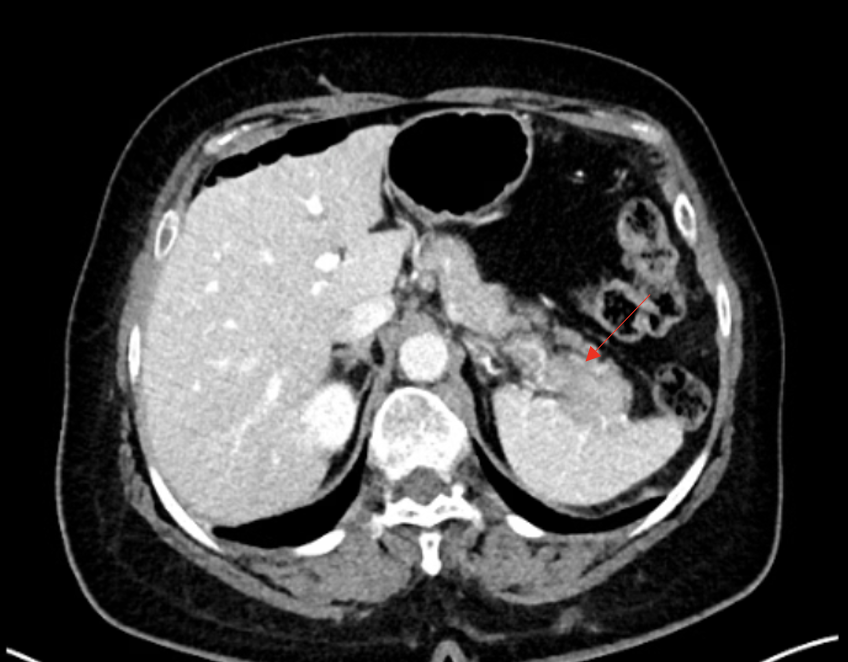Tuesday Poster Session
Category: Biliary/Pancreas
P4485 - Extranodal Rosai-Dorfman Disease With Pancreatic Involvement
Tuesday, October 28, 2025
10:30 AM - 4:00 PM PDT
Location: Exhibit Hall
- LS
Lauren Sanchez, MD
Vanderbilt University Medical Center
Nashville, TN
Presenting Author(s)
Vanessa I. Rodriguez, MD, Lauren Sanchez, MD, Melanie Naranjo, MD, Rishi Naik, MD
Vanderbilt University Medical Center, Nashville, TN
Introduction: Rosai-Dorfman disease (RDD) is a rare histiocytic disorder typically presenting with cervical lymphadenopathy. Extranodal involvement occurs in 40% of cases, with pancreatic involvement being extremely rare. The etiology remains unclear, though immune dysfunction and viral infections have been suggested as triggers. We present a case of extranodal RDD with pancreatic involvement discovered during anemia workup, confirmed through characteristic histopathological findings of emperipolesis and S100-positive histiocytes.
Case Description/
Methods: A 66-year-old female presented initially with alternating bowel habits and microcytic anemia. Due to persistent microcytosis, a CT was performed in October 2020, revealing an infiltrative soft tissue mass in the pancreatic tail with splenic vein narrowing, right inguinal lymphadenopathy, and symmetric paraspinal masses suggestive of extramedullary hematopoiesis (Figure 1). Endoscopic Ultrasound-Guided Fine Needle Aspiration (EUS-FNA) of the pancreatic mass showed macrophages with emperipolesis, suspicious for extranodal RDD. The patient was referred to hematology for further evaluation. Laboratory evaluation revealed iron 37 mcg/dL (50-175), iron binding capacity 228 mcg/mL (250-450), hemoglobin 12.4 gm/dL, MCV 70 fL, absolute lymphocytes 0.72 x10(3)/mcL, ESR 38 mm/hr, CRP 19.5 mg/L, positive ANA (1:640), elevated anti-dsDNA, positive SSA/SSB and Smith antibodies. PET-CT showed FDG-avid disease in the pancreatic tail/splenic hilum, lymph nodes, and paraspinal regions. Left cervical node excision demonstrated S100-positive histiocytes with emperipolesis, confirming RDD. Following diagnosis, given the absence of symptoms and clinical stability, a conservative management approach was chosen. The patient has remained clinically stable since diagnosis with continued observation.
Discussion: Pancreatic involvement is an exceedingly rare manifestation of RDD, with only a handful of cases reported in the literature. The diagnosis was established through the characteristic finding of emperipolesis in combination with S100-positive histiocytes, demonstrating the importance of adequate tissue sampling and immunohistochemical analysis. Our case illustrates the multisystem nature of RDD and value of systematic evaluation in rare disorders.

Figure: Figure 1: Axial contrast-enhanced CT scan of the abdomen demonstrating an infiltrative soft tissue mass in the pancreatic tail (red arrow) with associated splenic vein narrowing.
Disclosures:
Vanessa Rodriguez indicated no relevant financial relationships.
Lauren Sanchez indicated no relevant financial relationships.
Melanie Naranjo indicated no relevant financial relationships.
Rishi Naik indicated no relevant financial relationships.
Vanessa I. Rodriguez, MD, Lauren Sanchez, MD, Melanie Naranjo, MD, Rishi Naik, MD. P4485 - Extranodal Rosai-Dorfman Disease With Pancreatic Involvement, ACG 2025 Annual Scientific Meeting Abstracts. Phoenix, AZ: American College of Gastroenterology.
Vanderbilt University Medical Center, Nashville, TN
Introduction: Rosai-Dorfman disease (RDD) is a rare histiocytic disorder typically presenting with cervical lymphadenopathy. Extranodal involvement occurs in 40% of cases, with pancreatic involvement being extremely rare. The etiology remains unclear, though immune dysfunction and viral infections have been suggested as triggers. We present a case of extranodal RDD with pancreatic involvement discovered during anemia workup, confirmed through characteristic histopathological findings of emperipolesis and S100-positive histiocytes.
Case Description/
Methods: A 66-year-old female presented initially with alternating bowel habits and microcytic anemia. Due to persistent microcytosis, a CT was performed in October 2020, revealing an infiltrative soft tissue mass in the pancreatic tail with splenic vein narrowing, right inguinal lymphadenopathy, and symmetric paraspinal masses suggestive of extramedullary hematopoiesis (Figure 1). Endoscopic Ultrasound-Guided Fine Needle Aspiration (EUS-FNA) of the pancreatic mass showed macrophages with emperipolesis, suspicious for extranodal RDD. The patient was referred to hematology for further evaluation. Laboratory evaluation revealed iron 37 mcg/dL (50-175), iron binding capacity 228 mcg/mL (250-450), hemoglobin 12.4 gm/dL, MCV 70 fL, absolute lymphocytes 0.72 x10(3)/mcL, ESR 38 mm/hr, CRP 19.5 mg/L, positive ANA (1:640), elevated anti-dsDNA, positive SSA/SSB and Smith antibodies. PET-CT showed FDG-avid disease in the pancreatic tail/splenic hilum, lymph nodes, and paraspinal regions. Left cervical node excision demonstrated S100-positive histiocytes with emperipolesis, confirming RDD. Following diagnosis, given the absence of symptoms and clinical stability, a conservative management approach was chosen. The patient has remained clinically stable since diagnosis with continued observation.
Discussion: Pancreatic involvement is an exceedingly rare manifestation of RDD, with only a handful of cases reported in the literature. The diagnosis was established through the characteristic finding of emperipolesis in combination with S100-positive histiocytes, demonstrating the importance of adequate tissue sampling and immunohistochemical analysis. Our case illustrates the multisystem nature of RDD and value of systematic evaluation in rare disorders.

Figure: Figure 1: Axial contrast-enhanced CT scan of the abdomen demonstrating an infiltrative soft tissue mass in the pancreatic tail (red arrow) with associated splenic vein narrowing.
Disclosures:
Vanessa Rodriguez indicated no relevant financial relationships.
Lauren Sanchez indicated no relevant financial relationships.
Melanie Naranjo indicated no relevant financial relationships.
Rishi Naik indicated no relevant financial relationships.
Vanessa I. Rodriguez, MD, Lauren Sanchez, MD, Melanie Naranjo, MD, Rishi Naik, MD. P4485 - Extranodal Rosai-Dorfman Disease With Pancreatic Involvement, ACG 2025 Annual Scientific Meeting Abstracts. Phoenix, AZ: American College of Gastroenterology.
